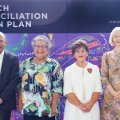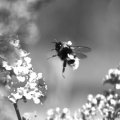South-east Queensland's pleasant sub-tropical climate is both a professional curse and a blessing for University of Queensland staff members Windsor Davies and Hans Habekotte.
The curse is the climate - an ideal breeding ground for fungus and mould growth on optical surfaces, such as in optical microscopes. Fungal contamination, if neglected, will etch onto the surfaces destroying the surface and non-reflective coatings.
The blessing is that Mr Davies and Mr Habekotte will never be short of things to do. As senior technical officers for the University's Optical Microscope Repair Service, they have developed a high level of expertise in repairing and maintaining a wide range of microscopes, many of which are not supported by the original vendors.
Currently, the University's Microscope Service repairs the University's collection of more than 4500 precision research and teaching optical microscopes, with a replacement value exceeding $10 million.
Established in 1948 at the University's Medical School at Herston, the Service has operated for the past 20 years from University premises at Kelvin Grove, and in November will move to refurbished premises on Services Road, previously occupied by the Glass Centre, at the University's St Lucia campus.
The Service is now under the direction of the University's Centre for Microscopy and Microanalysis (CMM). Its relocation will improve access by University staff and students to Mr Davies and Mr Habekotte's skills in optics, optical repairs, microphotography and instrument restoration.
Move co-ordinator and CMM Deputy Director Associate Professor Alasdair McDowall said a modern research microscope often commanded more than $100,000 from hard-earned grants. Therefore, regular microscope maintenance should be a primary concern for research investigators to retain the value of investment and to provide users with quality results.
'It is essential that research microscopes with their expensive optics are cleaned at least annually, while all microscopes should have a complete service every two to three years,' he said.
He said the Microscope Repair Service, operating on a fee-for-service, supported University departments and also had service contracts with external agencies and clients including several Brisbane hospitals, other educational institutions and the armed forces. The staff provided specialist knowledge and experience and offered on-site consultation on instruments as well as urgent problem solving and fault finding.
The Service used high precision centre lathes, milling machines, specialised hand tools and spray painting facilities, enabling staff to offer various 'one-off' items and modifications to existing equipment, such as camera adaptors, jigs and devices for research projects, normally not available commercially.
Dr McDowall said Mr Davies had many years experience in servicing and repairing surveying equipment, theodolites and levels and currently provided an in-house service in this field to researchers at the University's Gatton College campus.
The Microscope Repair Service also has maintained a magnificent collection of more than 150 microscopes and optical instruments dating back to the early 1800s.
Curator Mr Davies has expanded the collection which also includes old projectors, magnifiers, slides and surveying instruments, with many pieces donated by University staff and the general public.
Some collection highlights will be displayed in the new Molecular Biosciences Institute to be built at the University's St Lucia campus.
Mr Davies, an expert in restoring antique brass instruments, said that the complex restoration process included hand-finishing, polishing, machining, hot and cold lacquering, and enamel painting.
He is currently using these rare skills to overhaul Queensland Museum's collection of antique microscopes, for future public display.
Dr McDowall said the Executive Deans of the Faculties of Biological and Chemical Sciences; and Engineering, Physical Sciences and Architecture had recognised the essential nature of the service's operations and had supported its re-location.



